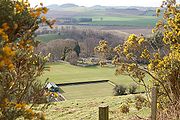
Kemback
Encyclopedia

Fife
Fife is a council area and former county of Scotland. It is situated between the Firth of Tay and the Firth of Forth, with inland boundaries to Perth and Kinross and Clackmannanshire...
, Scotland
Scotland
Scotland is a country that is part of the United Kingdom. Occupying the northern third of the island of Great Britain, it shares a border with England to the south and is bounded by the North Sea to the east, the Atlantic Ocean to the north and west, and the North Channel and Irish Sea to the...
, located 2.5 miles (4 km) east of Cupar
Cupar
Cupar is a town and former royal burgh in Fife, Scotland. The town is situated between Dundee and the New Town of Glenrothes.According to a recent population estimate , Cupar had a population around 8,980 making the town the ninth largest settlement in Fife.-History:The town is believed to have...
. The present village was developed in the 19th century to house those working the flax
Flax
Flax is a member of the genus Linum in the family Linaceae. It is native to the region extending from the eastern Mediterranean to India and was probably first domesticated in the Fertile Crescent...
mills on the nearby Ceres Burn. From 1681 the minister for the parish was Alexander Edward
Alexander Edward
Alexander Edward was a Scottish Episcopalian clergyman, who later became a draughtsman, architect and landscape designer...
, until 1689 when he was deprived as a non-juror
Non-juror
A non-juror is a person who refuses to swear a particular oath.* In British history, non-jurors refused to swear allegiance to William and Mary; see Nonjuring schism...
. He went on to become an architect
Architect
An architect is a person trained in the planning, design and oversight of the construction of buildings. To practice architecture means to offer or render services in connection with the design and construction of a building, or group of buildings and the space within the site surrounding the...
and landscape architect
Landscape architect
A landscape architect is a person involved in the planning, design and sometimes direction of a landscape, garden, or distinct space. The professional practice is known as landscape architecture....
, working on schemes for Brechin Castle
Brechin Castle
Brechin Castle is a castle located in Brechin, Angus, Scotland. The castle is the seat of the Earl of Dalhousie, who is the clan chieftain of Clan Maule of Panmure in Angus, and Clan Ramsay of Dalhousie in Midlothian. The original castle was constructed in stone during the 13th century...
and Hamilton Palace
Hamilton Palace
Hamilton Palace was a large country house located north-east of Hamilton, South Lanarkshire, Scotland. The former seat of the Dukes of Hamilton, it was built in 1695 and subsequently much enlarged. The house was demolished in 1921 due to ground subsidence despite inadequate evidence for that...
.
Transatlantic Radiophone Station
Kemback G.P.O. Transatlantic Radiophone Station (1927–1950s)Most hills in the UK were surveyed by the Marconi company during the 1920s. Kemback Hill; made up of layers of sandstone, slate, and poor concentrations of lead and silver minerals, is a natural amplifier.
In 1927 the General Post Office opened a commercial radiophone service between Kemback and an AT&T
AT&T
AT&T Inc. is an American multinational telecommunications corporation headquartered in Whitacre Tower, Dallas, Texas, United States. It is the largest provider of mobile telephony and fixed telephony in the United States, and is also a provider of broadband and subscription television services...
site in New Jersey, USA. All that remains (2010) is a metal gate into an open field opposite the Kemback graveyard. The field was originally full of wooden huts, and the hill, and surrounding areas in the parish, were covered in aerials. The civilian GPO services were moved when line of sight was needed for television transmissions during the 1950s.
WW2 Secret
Access to most of North Fife was restricted. The Kemback Radio Station was a critical link between Britain and the USA, Iceland, Sweden, Norway, and Russia. Classed ULTRA secret, the Kemback station was also needed in the event of a retreat from England, and the loss of the transatlantic cables by the British forces and an equivalent Transatlantic RadioPhone site at Rugby, England. Obviously this eventuality was never needed.Wartime records of the Station's use for radio interception as part of the network of Y-stations
Y-stations
Y-stations were British Signals Intelligence collection sites initially established during World War I and later used during World War II. These sites were operated by a range of agencies including the Army, Navy and RAF plus the Foreign Office , General Post Office and Marconi Company receiving...
for German Enigma machine
Enigma machine
An Enigma machine is any of a family of related electro-mechanical rotor cipher machines used for the encryption and decryption of secret messages. Enigma was invented by German engineer Arthur Scherbius at the end of World War I...
transmissions are still restricted, and have not been released into the public domain. It is unclear if the records survive in the National Archives or Bletchley Park
Bletchley Park
Bletchley Park is an estate located in the town of Bletchley, in Buckinghamshire, England, which currently houses the National Museum of Computing...
.
Several staff based in GPO Kemback were transferred to the Far East in the early days of WW2 to Singapore. Some were captured, and held as prisoners of the Japanese for the remainder of the war.
Medical conditions
The extremely marshy land immediately around the old and new Kemback churches was drained in the 17th and 18th centuries. A local condition called The Drop or The Ague is recorded in the histories of the Lairds of Kemback, and the archive of the Archbishop John SpottiswoodeJohn Spottiswoode
John Spottiswoode was an Archbishop of St Andrews, Primate of All Scotland and historian of Scotland.-Life:...
(17th C) which, although cannot be confirmed, is probably a form of malaria, similar to that seen in the Somerset levels.

